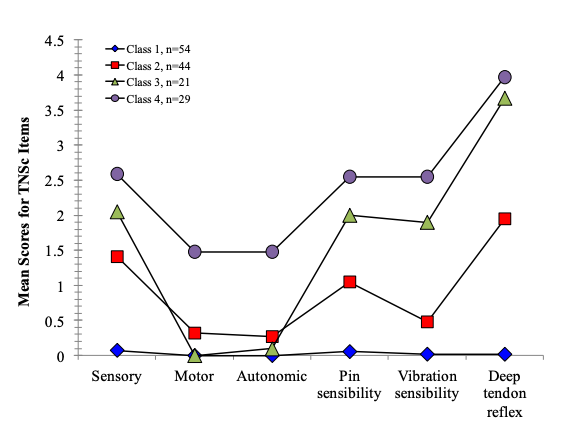
This graph shows four classes of colorectal cancer patients, indicated by different colors/shapes. The grouping shown is based on the latent class analysis on six neuropathy pain scores. Patients in class 1 had no pain for any item assessed while the patients in class 4 had pain symptoms for almost all items. The pain symptoms are moderate for patients in class 2 or class 3.
Researcher:
 Shijun Zhu, PhD, DrE, associate professor and statistician
Shijun Zhu, PhD, DrE, associate professor and statistician
Associate Director, University of Maryland, Baltimore Institute for Clinical and Translational Research Biostatistics Core
Areas of Expertise:
Zhu focuses on the application of cutting-edge statistical methods in nursing research, including multilevel modeling, survival analyses, mediation analyses, factor analyses, and structural equation modeling. He is currently developing methodological research on the complex modeling of longitudinal outcomes over time, such as recurring events, and joint modeling of multiple outcomes, commonly used in medical and social research studies.
Zhu was honored as the recipient of UMSON’s 2020 Distinguished Scholarship Award. “In assisting faculty and doctoral students with the development of research projects, Dr. Zhu works tirelessly to help researchers align the theoretical model, aims, research methods, and analysis plans,” said Erika Friedmann, PhD, professor and associate dean for research, in her nomination letter for Zhu. “This often necessitates multiple iterations. The success of research projects depends on the successful integration of these components. In this age of team science, this is a crucial and indispensable role.”
The BIG idea:
Zhu has been a co-investigator or statistician on more than 20 National Institutes of Health (NIH)-funded research projects with UMSON researchers, including “Function and Behavior Focused Care for Nursing Home Residents with Dementia,” “Testing the Efficacy of FFC-AC-EIT in Patients with Alzheimer’s Disease and Related Dementias,” “A Theory-Based Patient Portal eLearning Program for Older Adults with Chronic Illnesses,” and a recently funded “Neurophysiological and Transcriptomic Predictors of Chronic Low Back Pain: Towards Precision Pain Management (NEAT Study).” He has applied advanced statistical techniques to promote nursing and health research and to answer research questions that could not be answered with traditional statistical models. He has also raised new research questions from a methodological perspective.
Why does the research matter?
“To answer nursing and health research questions, it is essential to apply the most appropriate statistical models to the collected data, with the understanding of the assumptions underlying each model,” Zhu explains. “Ignoring these assumptions can lead to different and often incorrect conclusions.”
In collaboration with other researchers, Zhu has contributed to optimizing research design and to ensuring the most appropriate statistical models are used for research questions. He has also contributed to the development of novel statistical approaches, e.g. joint modeling on multiple outcome measures to disentangle the complex relationships between variables over time in the longitudinal studies.
Who does the research matter to?
Zhu’s research focuses on the advancement of novel statistical analysis methods in nursing research and the application of these methods through collaborations with UMSON’s faculty, PhD students, and postdoctoral fellows.
His collaborations also extend beyond UMSON. As an associate director of UMB’s Institute of Clinical and Translational Research (ICTR) Biostatistics Core, Zhu devotes time to statistical consultations with researchers throughout the University of Maryland, Baltimore (UMB) campus. The ICTR Biostatistics Core offers up to 25 hours of free research-related biostatistical services per research project and access to large datasets for UMB faculty.
“His expertise in research design/statistical analysis facilitates research addressing the health of disparate populations, including, among others, HIV-positive women, aging adults, patients with a variety of chronic conditions, health care workers, pregnant women, at-risk youth, individuals with mental illness, and community members,” Friedmann explains.
His research on statistical approaches meets a need for researchers across disciplines, particularly in epidemiology and clinical health research. Frequently, researchers have to ignore potential interrelationships because available statistical approaches cannot include them; Zhu’s work enables researchers to address their questions in a less constrained way that more closely mirrors real life.
What are the clinical applications of the research?
One of Zhu’s roles is to collaborate with UMSON principle investigators (PIs) on grant-funded research projects to determine the best approach to disentangle complex research questions, including animal models, clinical trials, and health/behavior interventions. He works with the PIs from the pre-award stage through implementation of the research project to completion of the project and analyses of the data and interpretations of the findings.
“Application of novel statistical methodologies such as latent class analysis and longitudinal mediation analysis can guide researchers to achieve their goals within more targeted subpopulations, thus lowering research costs,” Zhu says. For example, he has applied latent class analysis, which identifies clusters of related cases, to classify colorectal cancer patients into a few elevated risk groups based on their symptoms and signs, which narrowed down the search for patients who might have the potential genes that were hypothesized to have effects on these symptoms.
Zhu has also been essential to developing a “nonparametric maximum likelihood estimation” approach to jointly modeling multivariate longitudinal outcomes with informative recurrent events. This approach uses available data to predict outcomes, rather than the more commonly used approaches that assume normal distributions of predictors and outcomes. The application of such modeling has included evaluating the associations among biomarkers such as glutamine and ammonia levels collected during regular clinical visits and irregular episodes among patients with urea cycle disorder, a metabolic disease. Joint modeling advances the use of individual models to address highly correlated outcomes that often occur in medical and nursing research.